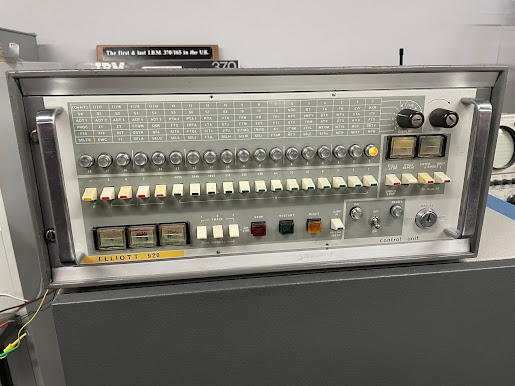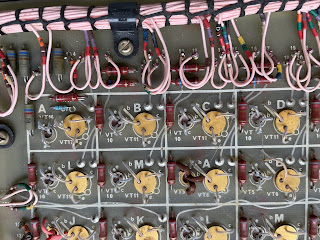920C Control Panel project
Reviving an Elliott 920C control panel
As a vounteer at the UK National Museum of Computing (TNMOC), I've started a project to breath life into this 1960s Elliott 920C control panel.
This
is just the control panel module for a 920C computer, which sadly we don't have as
an exhibit. So at present it's a static exhibit. The original idea was to simply animate the control panel by
lighting the lamps by flicking a switch. This has significantly expanded into actually
building a Raspberry Pi Elliot 900 Emulator*, and controlling it from the 920 control panel. A perfect example of Scope Creep at its finest !
* There is an active Elliott 900 Emulator community, I've selected Andrew J Herbert's 900 Emulator in C, as Andrew is handily close by for many questions - he is the chair of the TNMOC Trustees !).
Initial feasability tests
The initial 2 tasks was to get a Pi C software framework in place to read switches and light lamps, and secondly see what's inside the Control Box.
This is my Pi setup. My laptop running VNC (as my Pi screen is tiny), my Pi 400, a breadbord for GPIO prototypes, and an AB Electronic IO Plus I2C 32 port expansion card.
As there are a
multitude of switches & lamps in the 920C box, many more than there are Pi GPIO pins to drive them; I decided on the I2C card to get the additional I/O ports. You can see my test cards for switches and LEDs, which are all driven by the I2C card.
Inside the 920C box, there is extensive wiring and a lamp/audio driver boards.
From
previous Elliott restorations my
co-conspirator Peter Williamson knew that the switches would have spare
connectors that we could use, without doing any damage. These have been tested with a multimeter.
The front panel above photo above shows our
first test - to use the lamp driver to light a lamp, triggered by a
signal from the Pi (in this case a GPIO pin). We also piggy backed the Pi +/- 5V supply for the 920 circuitry. The actual voltage inside the 920 is 6V, but all seemed to work.
PeterW has found a convenient spot to connect a trigger wire.
I have compiled the 900 Emulator C code on my Pi400 had a tinker, and I think I now know enough to be dangerous ;o)
Sadly the external connectors on the rear of the 920C box seem to be very old MilSpec jobs, and will not be easy to source (or solder for that matter - the larger one has > 50 connectors !)
So far, so good, all our feasability tests are completed.
18/122/2021 update:
Design
The main components are centred around a Raspberry Pi 4, with HAT expanders - 2 x AB Electronics I2C, and generic GPIO header. There is a RS 5v 10A psu, some project board and port repeaters through the case for HDMI, keyboard, mouse and USB-C connector. Wiring to the 920C will be via DB25 connectors.
For software as there's a lot of hardware interaction I chose C, plus the BCM2385 by Mike McCauley library for GPIO interaction, and the AB Electronics C routines for I2C interfacing. The GUI is written in C plus the Gtk toolkit.This is the old aluminium radio case rescused from the Hut 24 skip. I have a new perspex front panel for it. (11/01/22 update)
Slow progress due to the amount of soldering, and I'm not an electronics hobbyist.
I have managed to solder the 40-pin GPIO headers, and 20 pin connectors to the I2C boards, and to build the HAT stack.
Today I'm adding the 20+ resistors to the project board in the photo. Next job is to install all the bits into the radio case and test.
I've the components for a "production build"
- a Pi 4b (4Gb ram - doesn't need that much, but was the smallest in stock @ PiHut)
- Pi HAT expanders 2 x I2C, and a GPIO connector), a tatty old radio case to house the all bits (rescued from the TNMOC skip next to Hut 24)
- an old screen from the TNMOC office to use to run the PPT & TTY input/output emulation software.
- A beefier RS 10Amp PSU for the 5amps needed to drive all the 920 circuits (plus up to 3amps for the Pi) ,
- DB25 connectors (ubiquitous and realtively easy to solder),
- Pi USB/HDMI etc port replicators to fit on the case.
- Bit of perspex for the radio case back panel and to host the necessary holes for DB25 connectors
Next steps
- Assemble all the bits, and solder, solder, solder !
- Wrap the 900 emulator software with a GUI, that also interreacts with the Pi 920 driver I've written.
- Add some non-invasive connectors to the 920 swicthes & lamp-driver circuits.
- Make-up the DB25 connector cables.










Comments
Post a Comment